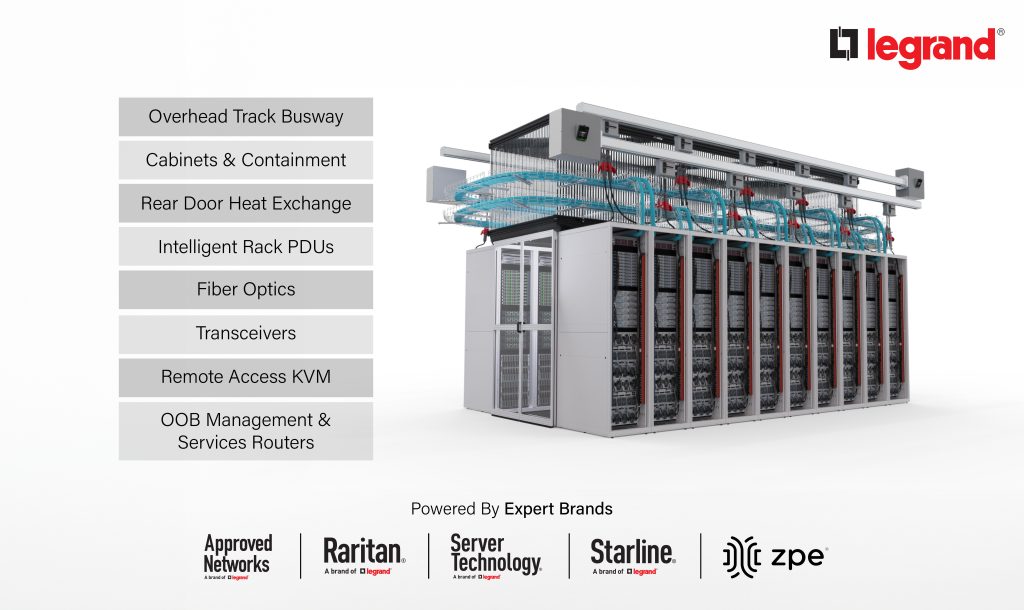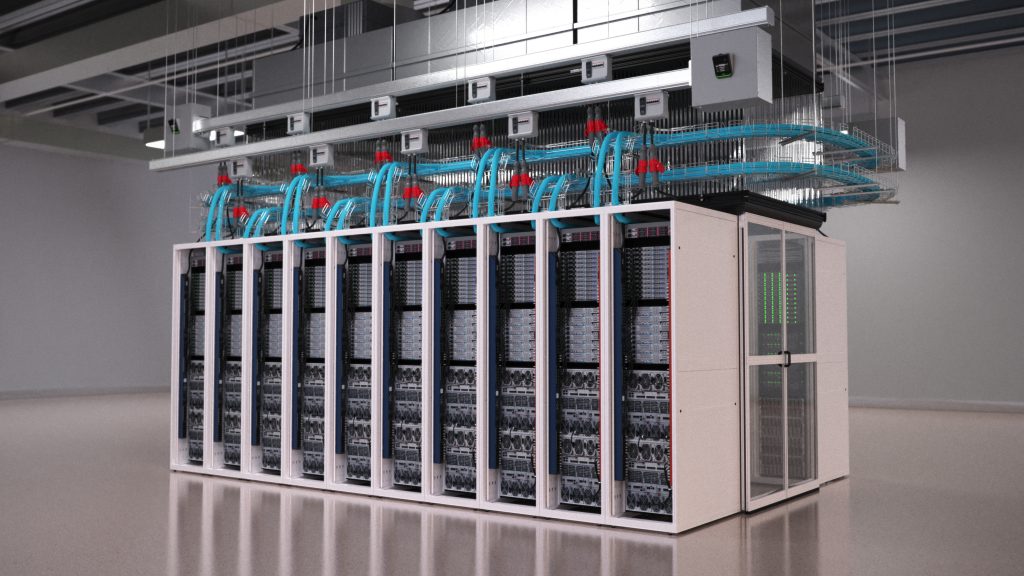In today’s fast-paced digital world, data centres are the backbone of global connectivity, powering everything from cloud services to essential business operations. However, the growing demand for data centres has also amplified their environmental impact, making it crucial to enhance efficiency while reducing their carbon footprint. This article explores practical steps organisations can take to improve data centre efficiency and significantly reduce their environmental impact. It case-studies Legrand, a global leader in electrical and digital infrastructure, and offers valuable insights into selecting the right solution partner.
The past few years have seen data centre operators make significant strides in carbon emissions reporting, covering direct emissions (Scope 1), energy-related emissions (Scope 2), and emissions from the supply chain and other indirect activities (Scope 3). While these efforts have traditionally focused on reducing energy consumption, a more comprehensive approach is needed to tackle the broader environmental impact, especially Scope 3 emissions. This will entail not just optimising internal operations but selecting and collaborating with suppliers who share a commitment to sustainability. By examining Legrand’s innovations, this article offers practical advice for enhancing data centre sustainability at every level, from company practices to product design and industry-wide influence.
Part 1: Legrand’s corporate culture of sustainability
Legrand is a global leader in electrical and digital infrastructure with reported revenue of €8.4 billion in 2023, operating across residential, commercial, industrial and data centre markets. While this article is centred on data centres, Legrand’s sustainability initiatives across its entire value chain also consider the carbon emissions of its products, which can directly influence the Scope 3 emissions of the companies that purchase them. Its corporate culture of sustainability is broken down into four actionable goals.
- To begin, Legrand is establishing clear medium- and long-term goals to reduce its environmental impact. By 2030, the company aims to reduce Scope 1 and 2 emissions from its operations by 42%. To support this, 150 initiatives have already been implemented to reduce energy use, with Legrand’s Data, Power and Control division cutting energy consumption by 1.4GWh in 2023. Overall, Legrand reported it achieved a 14GWh electricity saving between 2022 and 2023, a staggering 39% reduction when compared to 2021. Additionally, 84% of the electricity used in Legrand’s manufacturing and distribution sites now comes from renewable sources, with 25% of these sites equipped with a renewable microgrid.
- Legrand aims to reduce Scope 3 carbon emissions by 25% by 2030. A programme involving 250 suppliers has already secured commitments from 195 of them to reduce emissions by 215.5 ktons of CO2 by 2030.
- Legrand also plans for 80% of its sales to come from eco-responsible solutions by 2030, with the company estimating that 76% of its 2023 sales were from such products. To reach and exceed the 80% target, Legrand is focusing on improving product efficiency through R&D and adopting Circular Economy principles. This includes using 15% recycled plastic and 40% recycled materials in its products and eliminating single-use plastics in packaging. The company reported it has already increased the use of recycled or certified renewable materials from 73% in 2022 to 85% in 2023. A notable achievement by Legrand’s Data, Power and Control division was reducing packaging weight by over 700 tons between 2022 and 2023.
- Lastly, Legrand has committed to becoming carbon neutral by 2050, matching pledges by the US, UK and EU governments. This will involve a 90% reduction in carbon emissions with the remaining 10% offset through investments in projects like protecting Kenyan flora and fauna and extending the New Delhi metro. These ambitious goals are validated by the Science Based Targets Initiative and will reduce Legrand’s Scope 1, 2 and 3 emissions, thereby directly lowering the Scope 3 emissions of its clients.
Part 2: Sustainability in product design and operations
Legrand’s data centre product portfolio includes power distribution, cabinets, cooling and management solutions. The company’s commitment to sustainability is evident in its approach to product development, which includes selecting sustainable materials, optimising production and logistics, and designing products with a longer lifespan. A key focus is on reducing the embodied carbon in its products. Since 2014, Legrand has integrated eco-design principles into its R&D processes, this approach prioritises sustainability in product design and lifecycle assessment.

Legrand’s efficient design principles: From lower power consumption to modularity
Track busways for power distribution: Compared to cables or conduit, Legrand’s busways are inherently more efficient for power distribution, thereby reducing voltage loss and energy waste. The busbars it uses in these systems offer superior resistance in short-circuit scenarios and minimise resistance induction through optimal conductor spacing. This results in lower voltage loss, reduced harmonic distortion and improved energy efficiency. Starline, Legrand’s track busway brand, enhances flexibility by offering continuous access slots along the busway which enables easy reconfiguration.
Rack-Level Power Distribution: Raritan and Server Technology, Legrand’s rack power distribution unit (PDU) brands, have engineered PDUs to enhance sustainability. Their patented High Density Outlet Technology (HDOT) maximises outlet space, reducing the need for additional PDUs, while the HDOT Cx outlet accommodates both C14 and C20 power cables, which extends the lifespan of rack PDUs. Advanced power quality monitoring provides precise, real-time insights into power efficiency and equipment health, while remote management features can be utilised to optimise power usage by identifying idle servers.
IT Cabinet and Cooling Design: Legrand’s IT cabinets are engineered to minimise airflow leakage and enhance cooling efficiency. Accessories such as rail-mounted blanking panels and adjustable mounting rails with seals further improve airflow management. Containment solutions like Contain-IT FLEX. which are designed for specific row configurations, maximise cooling efficiency and reduce energy consumption in high-density environments.
Cooling Solutions: USystems, Legrand’s rear door heat exchanger (RDHx) specialists, have developed an RDHx with a closed water loop system that significantly reduces water wastage. Their in-row cooling system is up to 60% more energy efficient than traditional CRAC units when addressing row-scale data centre hot points, with an industry-leading cooling capacity of 68kW.
Efficient Optical Networking: Legrand’s acclAIM fibre solutions design replaces pre-terminated cassette-based solutions with direct mating breakout connections, delivering one-to-one functionality, design, and administration while eliminating the cassette. acclAIM’s extended distance fiber solution of up to 160m for 1G and 107m for 10G applications, in some cases, reduces the need for additional signal-amplifying equipment, decreasing Scope 3 emissions by eliminating the need for this equipment.
Reducing Carbon Emissions in Manufacturing: Legrand maintains control over the fabrication, bending, painting, and assembly of its data centre IT cabinets and ensures reduced emissions from transportation of semi-finished goods from one location to another. USystems has eliminated water wastage in its manufacturing process and uses renewable energy sources like biomass boilers and solar panels to power its plant.
Circular Economy Initiatives: Legrand actively incorporates Circular Economy principles across its product portfolio, focusing on reusability, recycled materials and recyclable packaging. For example, Starline’s track busway sections and plug-in units can be reconfigured and moved from one location to another, reducing waste during data centre redesigns. Legrand prioritises recycled materials, with USystems using recycled steel from cars for its RDHx solutions. Additionally, Legrand’s packaging materials are designed to be recyclable, and logistics strategies are optimised to reduce carbon emissions.
Part 3: How data centres can become more sustainable with Legrand’s solutions
Legrand’s advanced monitoring features can significantly impact data centre sustainability by addressing IT underutilisation, which is a common inefficiency. By utilising real-time data provided by Raritan and Server Technology intelligent rack PDUs, data centre operators can optimise server and storage capacity, reduce power consumption and consolidate servers, which lowers energy usage.
By identifying and switching off idle servers, data centres can immediately enhance efficiency and reduce operational costs.
Legrand also understands how vital sustainable cooling and power distribution strategies are for data centre efficiency. At a cabinet level, Legrand’s airflow management solutions, can achieve a reduction in airflow leakage by up to 80%, and its containment moves this closer to 100%. For retrofits, adding sensors and sealing gaps between cabinets can optimise airflow. Additionally, Legrand’s RDHx systems can reduce cooling energy by up to 90% and lower water wastage, thereby enhancing overall energy efficiency.
On monitoring electrical systems, tools like Starline’s real-time power monitoring ensures balanced electrical systems and maximises energy efficiency. Advanced metering and real-time analytics help data centre operators maintain peak performance and reduce energy waste.

To promote sustainable operations and purchasing, Legrand incorporates low-maintenance infrastructure such as Legrand’s maintenance-free busways, and the company leverages remote management tools, which significantly reduce operational emissions.
Final words
The journey towards more efficient and sustainable data centre operations is both a challenge and an opportunity. Data centres can significantly reduce their carbon footprint while maintaining operational excellence by embracing a holistic approach that targets emissions across all scopes and by carefully selecting solution partners who share a commitment to sustainability.
For every organisation, the actions taken today will not only determine the environmental impact of individual data centres but also set a precedent for the industry as a whole. By prioritising innovation and collaboration, organisations can lead the charge in creating a more sustainable digital infrastructure and ensuring that the growth of our digital world does not come at the expense of our planet.
To learn more on practical solutions for engineering a sustainable data centre and how to maximise the value of existing technology, download the full case study here.



